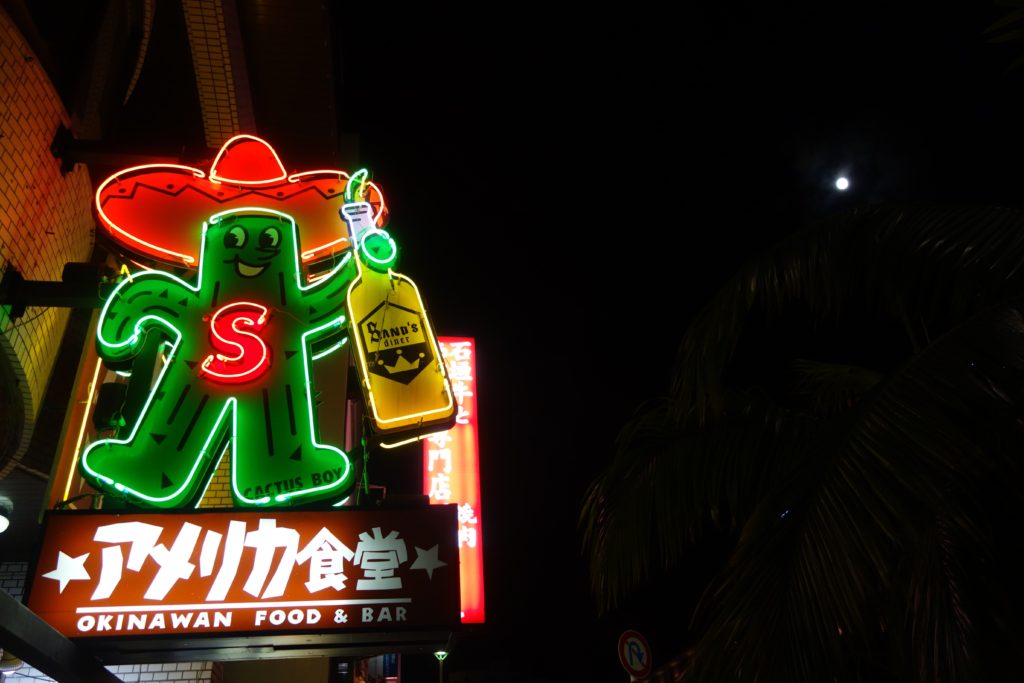
I had to step out of Korea this past weekend, and Peach, my discount airline of choice, offered three possible destinations: Osaka, the first city I ever visited in Japan and still the one in which I spend the most time; Tokyo, which I could stand to explore some more but which Peach only flies into and out of in the middle of the night; and Naha, the capital of Okinawa Prefecture, still terra incognita to me. I chose the mystery door number three, packed lightly enough to stay under Peach’s ten-kilogram carry-on limit (like most airlines in their class, they have a tendency to nickel-and-dime for everything from checked backs to paper cups of instant coffee), and figured I’d spend a day and a half or so exploring the city as extensively as I could, getting a quick hit of that always-savorable sensation of the urban unknown.

Having moved to Korea last November, October remains the only month I have yet to experience in full there, though Seoulites tell me that the air usually turns chilly somewhere toward the middle or end of it. We definitely got into sweater weather within the past couple of weeks, and so I wore one onto the plane, but right on the tarmac at Naha International I realized I shouldn’t have bothered. I stepped out not just into air much warmer than I’d expected, but under a sky blacker than any I’d ever seen before. It’s one thing to know your destination is a tropical island, but quite another to have enough experience with tropical islands — I’ve never even set foot on Jeju, Korea’s Okinawa, or Hawaii, America’s — to put yourself physically into tropical receptivity mode before you get there.

Waiting to get through immigration, I researched where to get a plate of taco rice once I got into Naha proper. Most of the knowledge about Okinawa I’d brought in with me came directly from Nēnēs records (especially when made with Ryuichi Sakamoto) and Takeshi Kitano’s Sonatine, but I’d also come across the curious fact that this humble Tex-Mex plate had somehow come to represent modern Okinawan cuisine. Much like Korea’s budae jjigae, an equally un-photogenic stew involving Spam, instant ramen noodles, and a slice of American cheese, taco rice has a history wrapped up in that of the local U.S. military base. I never did spot a single American soldier (I’ve heard the areas they frequent in Okinawa make Itaewon look charming and prostitute-free), but I did manage to eat my fair share of the dish invented right outside the gates of their camp.
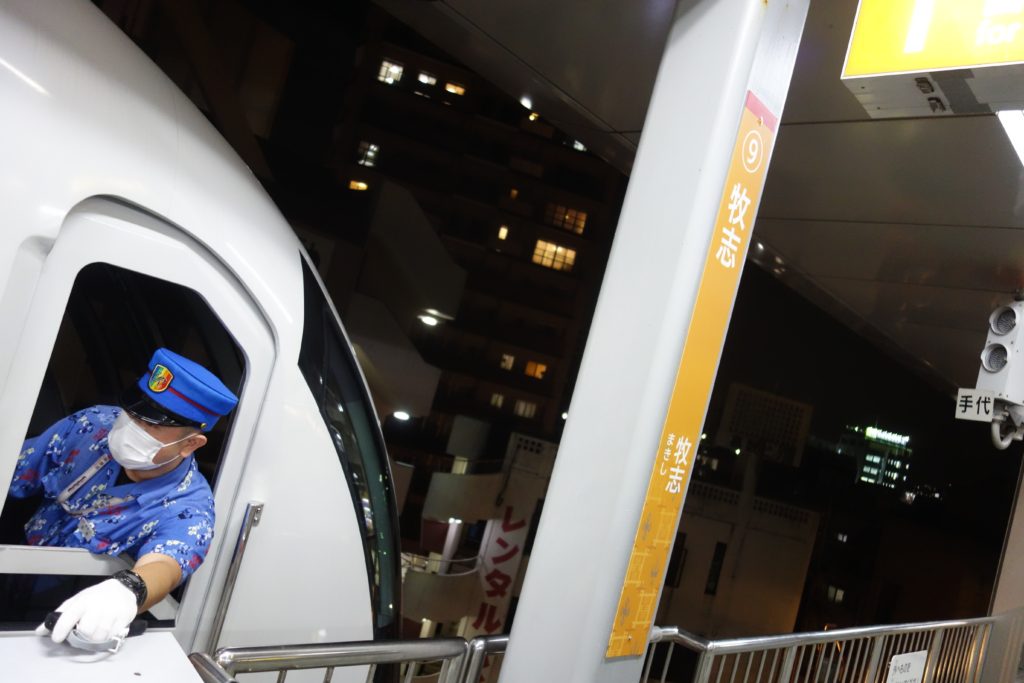
Since 2003, Naha has had a monorail connecting the airport to downtown and beyond, a pleasant surprise in a city of only about a million people. I had my Suica payment card (which, despite the fact that I don’t actually live in Japan, doesn’t leave my wallet these days) ready to go, but the monorail turned not to accept it, so I just bought an individual ticket at one of the machines, using the only piece of Japanese cash I had on me, a single ¥10,000 bill fresh from the ATM. The equivalent in America would be a $100 bill, the insertion of which into a vending machine of any kind — assuming the machine could even accept it — would have caused a life-threatening avalanche of change, but in Japan you just get back a manageable few coins along with a neat stack of bills automatically sorted into appropriate denominations. (Honolulu, meanwhile, has struggled for decades and spent billions of dollars to get a rail line built at all.)
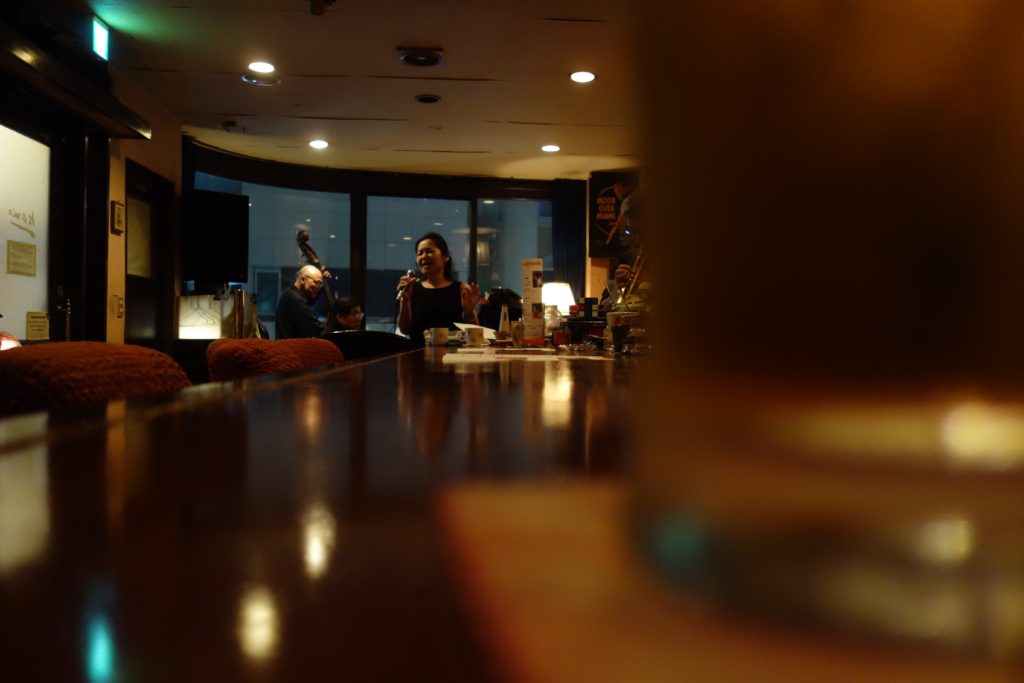
The more cities I experience, the more clearly I define the most revealing elements of a city to check out first: its rapid transit system and its representative dish, of course, but also its representative architect, its representative coffee shop, its representative jazz bar. I found that last soon after the monorail deposited me at one end of Kokusai-dōri, Naha’s main shopping street. Jazz Live Kam‘s, a Kokusai-dōri institution since lord knows when, brought to mind a description I once read of Peter Cat, the Tokyo jazz bar Haruki Murakami ran in the 1970s before becoming a writer: “a place where time stood still.” (I have a feeling Murakami himself would heartily approve of Kam’s, not least because of the cats, a couple of Naha’s countless healthy-looking strays, reliably found asleep outside the entrance of the building.) I stopped in to listen for a couple of hours, and the night’s quintet (including owner Hidefumi Kamura, “Kam” himself, on the piano) played its last few sets of the night to an audience consisting only of me.
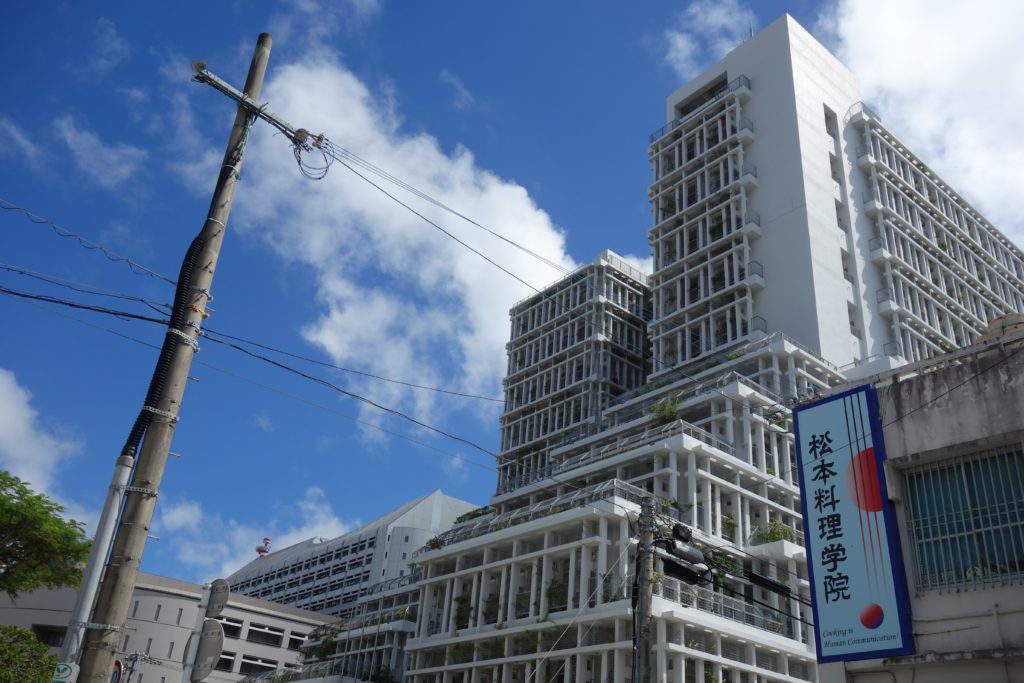
I took the measure of Naha’s coffee situation the following morning, as the first customer of the day at Mahou Coffee, which opens at 10:00, limits itself to 66 cups sold per day, and prohibits in its book- and antique-decorated “silent coffee space” such un-tasteful things as computers, smoking, excessive photography, and children. Such an establishment would, I suppose, bear the label of a “third-wave” coffee shop in America, and probably get made fun of for all its rules and fragility, but in Japan it embodies everything one wants to see in a small business. From there I set out on foot in search of the work of the only Okinawan public architect I’d ever heard of, the still seemingly uncelebrated Nobuyoshi Kinjo, designer of Naha Tower, Naha Civic Hall, and the University of the Ryukyus Museum.
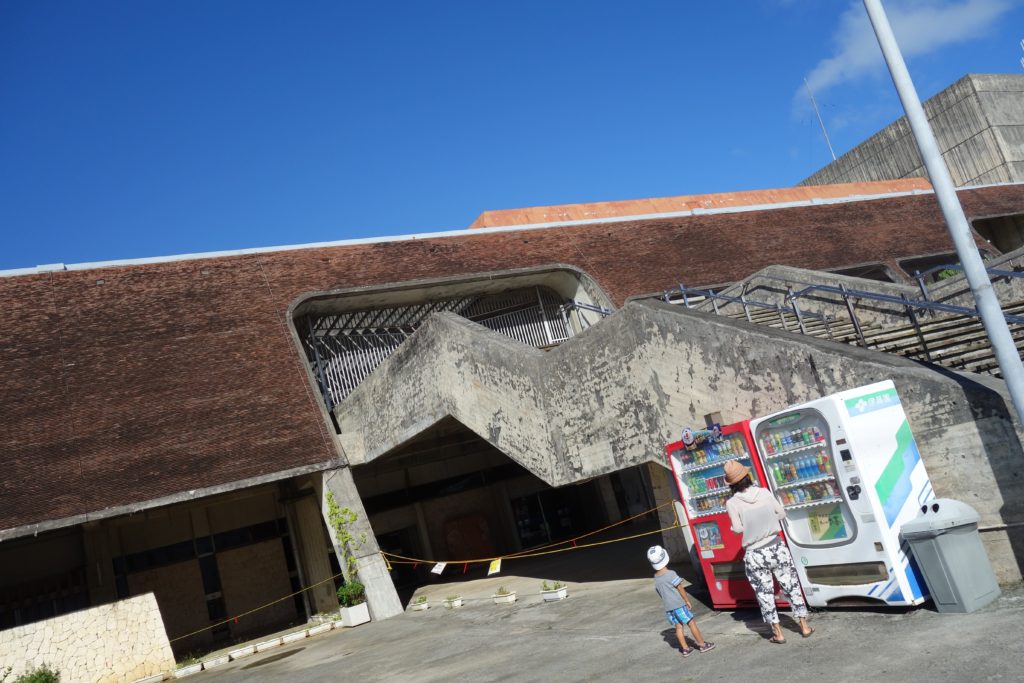
I couldn’t find Naha Tower, and after consulting its Japanese Wikipedia entry realized why: it was demolished in 2014, having stood for just over forty years (albeit empty since its owner’s 2008 bankruptcy). A few hours later, I arrived at Naha Civic Hall to find it still standing but mostly cordoned off and looking ready for the wrecking ball, its roof wrapped by the same palliative-looking netting I saw on Kisho Kurokawa’s Nakagin Capsule Tower earlier this year. Still, some of its offices remained open if seemingly unmanned, and I could get close enough to take pictures of Naha’s “pantheon of culture” in what a Japan Update article published just the day before confirmed as the final days before its closure “for good because of its deteriorated condition,” given that “a recent seismic capacity evaluation states there is a high risk that the hall would collapse in a case of an earthquake.”
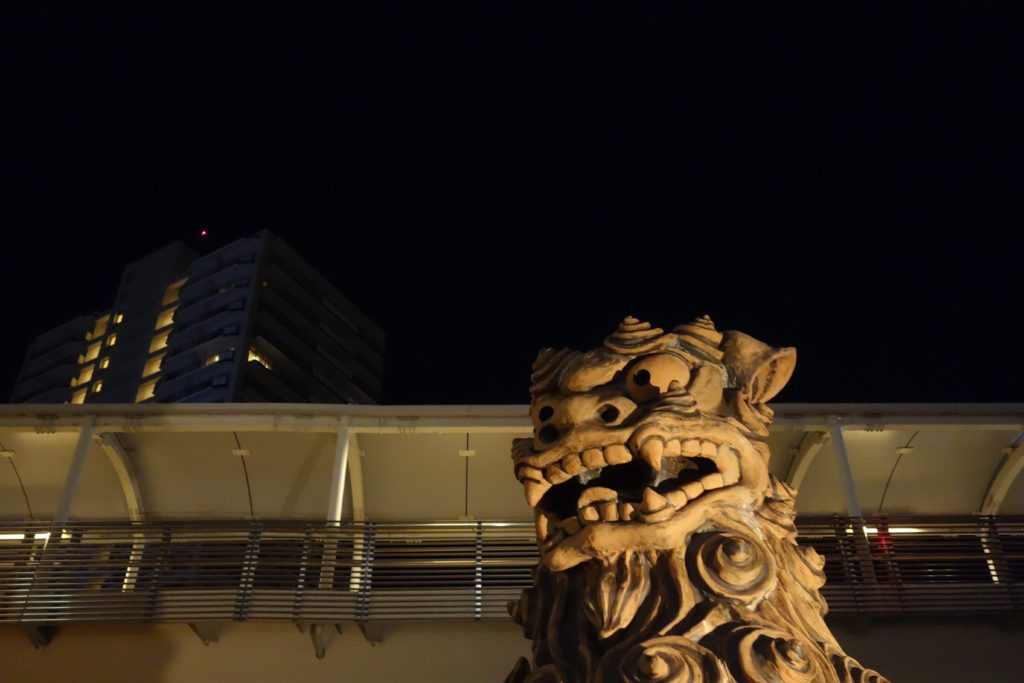
As I circled the building looking for angles, a primly dressed woman about my age approached and asked what I was doing. Smelling officialdom, I explained in my broken Japanese that I have an interest in architecture and just came to take pictures. “This building… will close,” she said, meeting me halfway in equally unsteady English and going on to ask why I’d come to Okinawa and whether I liked it. I told her I liked it quite a bit, even though I didn’t have much time to spend there, and that I’d certainly been enjoying the taco rice. “Oh, taco rice,” she said, somewhere in the middle of an oscillation between the languages. “My favorite!” Eventually, and as if she’d only just remembered why she’d struck up the conversation in the first place, she almost apologetically handed me a brochure. “Where can we find answers to life’s big questions?” asked its front page — the conclusion of the softest sell I’ve ever experienced from a Jehovah’s Witness.
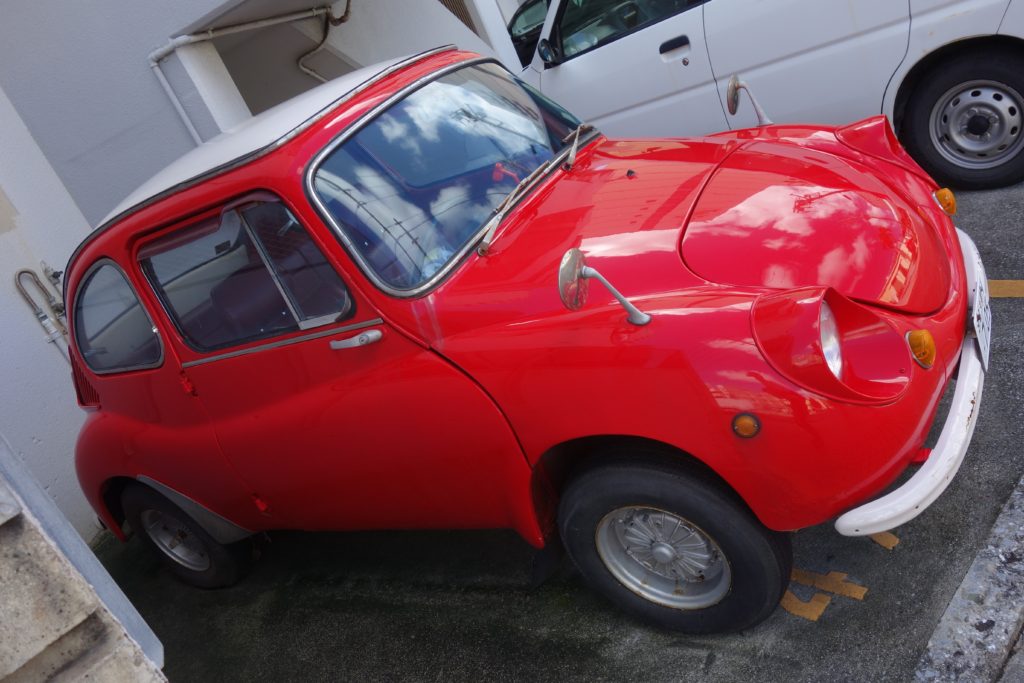
But then, nothing in humble Naha seems to come with a hard sell. Donald Richie once said he admired Osaka for its unabashed vulgarity, as I do, and what I enjoy about the capital of Okinawa has something reminiscent in it of what I enjoy about Kansai’s merchant metropolis. Call it a kind of urban rusticity, underscored even by the cars on the road: despite Japan’s formidable barriers to old-car ownership, in Naha I spotted a fair few spiffy old models from the 1970s or even 60s here and there (as well as newer ones clearly stylistically influenced by these same predecessors). The two cities also have in common the culture of the shotengai: despite Osaka’s comparative enormousness, Naha feels as if it has almost as many miles of covered market streets — or at least as much if not more life going on within them.

Still, the same rules I trust in the rest of urban Japan broadly apply in Naha. To reference Richie once more, “the places you have fun after dark in Japan are always hidden. The unknowing foreigner walks along Tokyo’s Ginza or along Kawaramachi in Kyoto, lonely, little knowing that just a few blocks over are lanes of bars and blocks of cabarets.” Stick, in other words, with the side streets and the shotengai, although I must say Kokusai-dōri, home of Kam’s Jazz, impressed me with how late it stayed active. But I did have my best taco rice by far on a narrower, darker parallel street, at a cantina called Borracho’s after finding the go-to high-street taco rice tourist spot closed for the night. It came sizzling on cast iron, just like a good bibimbap in Korea, and the waiter stirred in plenty of minced garlic as I watched. The memory, much like that of my private concert above Kokusai-dōri, has already taken on the feel of a dream.